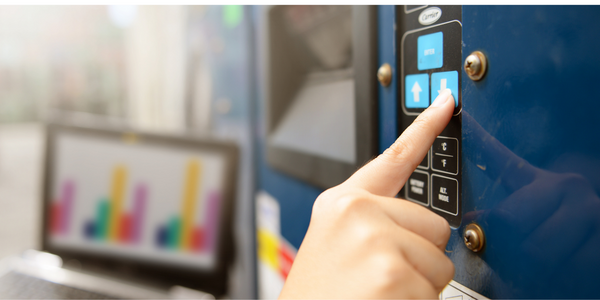下载PDF
Temperature and humidity monitoring solution

技术
- 功能应用 - 远程监控系统
- 传感器 - 湿度传感器
- 传感器 - 温度传感器
适用行业
- 医疗保健和医院
适用功能
- 商业运营
挑战
温控监控解决方案
血液站属于医疗卫生机构,负责收集和储存血液血液单位并将其提供给临床或血液生产单位。因此,血液中心血液站非常宝贵。温度和监控环境对于血液站中的产品的安全性非常重要。
客户
未公开
关于客户
-
解决方案
Kingpige 在血站温度和自动监控系统中的应用可以有效地管理环境中的环境和体温,精确测量体温和体温。
我们的S265设备可以通过传感器从冰箱中收集温度和自动数据,并发送到Kingpigeon云平台供我们进行监控。
云平台提供了多级管理和移动APP监控平台。温度和监控异常时。异常微警报可以通过语音,短信和信函实时通知管理人员。
使用King Pigeons完整的温度站和自动监控解决方案,血液能够有效远程控制温度和实时,。
主要产品
Kingpigeon S265温控远程监控
王鸽云平台
选择 Kingpigeon S265 为什么
支持远程温度和监控实时;
支持8通道温控输入接口(AM230x系列温控传感器);
通过短信/呼叫/GPRS发出高/低警报;
多达10个用户的电话号码可接收警报并每日报告短信/呼叫;
可报告,间隔时间1〜6535秒;自动将状态/值上传到授权号码
支持Android/IOS APP,轻松方便地使用/配置。
可在操作区域,不受任何限制;
收集的数据
Access Control Status
运营影响
相关案例.

Case Study
Hospital Inventory Management
The hospital supply chain team is responsible for ensuring that the right medical supplies are readily available to clinicians when and where needed, and to do so in the most efficient manner possible. However, many of the systems and processes in use at the cancer center for supply chain management were not best suited to support these goals. Barcoding technology, a commonly used method for inventory management of medical supplies, is labor intensive, time consuming, does not provide real-time visibility into inventory levels and can be prone to error. Consequently, the lack of accurate and real-time visibility into inventory levels across multiple supply rooms in multiple hospital facilities creates additional inefficiency in the system causing over-ordering, hoarding, and wasted supplies. Other sources of waste and cost were also identified as candidates for improvement. Existing systems and processes did not provide adequate security for high-cost inventory within the hospital, which was another driver of cost. A lack of visibility into expiration dates for supplies resulted in supplies being wasted due to past expiry dates. Storage of supplies was also a key consideration given the location of the cancer center’s facilities in a dense urban setting, where space is always at a premium. In order to address the challenges outlined above, the hospital sought a solution that would provide real-time inventory information with high levels of accuracy, reduce the level of manual effort required and enable data driven decision making to ensure that the right supplies were readily available to clinicians in the right location at the right time.

Case Study
Gas Pipeline Monitoring System for Hospitals
This system integrator focuses on providing centralized gas pipeline monitoring systems for hospitals. The service they provide makes it possible for hospitals to reduce both maintenance and labor costs. Since hospitals may not have an existing network suitable for this type of system, GPRS communication provides an easy and ready-to-use solution for remote, distributed monitoring systems System Requirements - GPRS communication - Seamless connection with SCADA software - Simple, front-end control capability - Expandable I/O channels - Combine AI, DI, and DO channels

Case Study
Driving Digital Transformations for Vitro Diagnostic Medical Devices
Diagnostic devices play a vital role in helping to improve healthcare delivery. In fact, an estimated 60 percent of the world’s medical decisions are made with support from in vitrodiagnostics (IVD) solutions, such as those provided by Roche Diagnostics, an industry leader. As the demand for medical diagnostic services grows rapidly in hospitals and clinics across China, so does the market for IVD solutions. In addition, the typically high cost of these diagnostic devices means that comprehensive post-sales services are needed. Wanteed to improve three portions of thr IVD:1. Remotely monitor and manage IVD devices as fixed assets.2. Optimizing device availability with predictive maintenance.3. Recommending the best IVD solution for a customer’s needs.

Case Study
HaemoCloud Global Blood Management System
1) Deliver a connected digital product system to protect and increase the differentiated value of Haemonetics blood and plasma solutions. 2) Improve patient outcomes by increasing the efficiency of blood supply flows. 3) Navigate and satisfy a complex web of global regulatory compliance requirements. 4) Reduce costly and labor-intensive maintenance procedures.

Case Study
Harnessing real-time data to give a holistic picture of patient health
Every day, vast quantities of data are collected about patients as they pass through health service organizations—from operational data such as treatment history and medications to physiological data captured by medical devices. The insights hidden within this treasure trove of data can be used to support more personalized treatments, more accurate diagnosis and more advanced preparative care. But since the information is generated faster than most organizations can consume it, unlocking the power of this big data can be a struggle. This type of predictive approach not only improves patient care—it also helps to reduce costs, because in the healthcare industry, prevention is almost always more cost-effective than treatment. However, collecting, analyzing and presenting these data-streams in a way that clinicians can easily understand can pose a significant technical challenge.





